Unit 4 I can play basketball Story time 教案
文档属性
| 名称 | Unit 4 I can play basketball Story time 教案 | 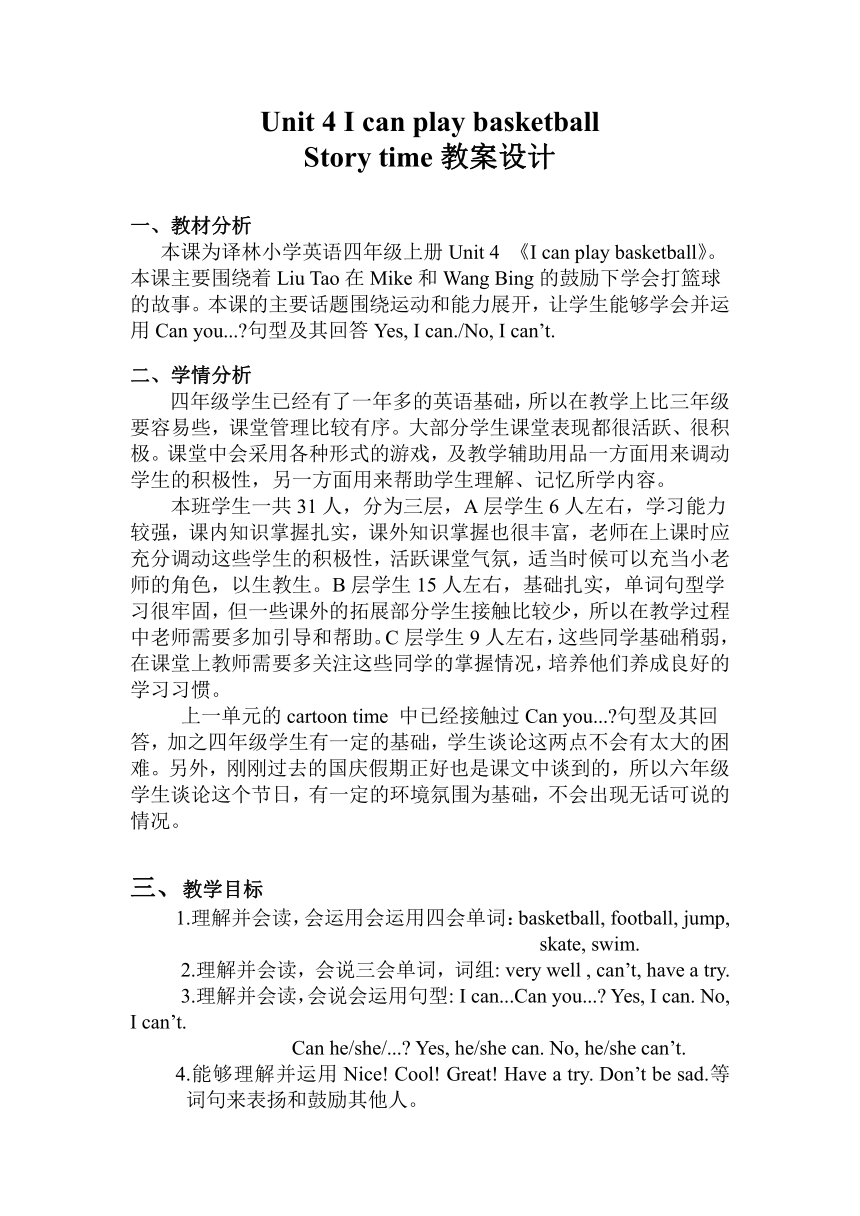 | |
| 格式 | docx | ||
| 文件大小 | 1.1MB | ||
| 资源类型 | 教案 | ||
| 版本资源 | 牛津译林版 | ||
| 科目 | 英语 | ||
| 更新时间 | 2021-10-12 11:04:38 | ||
图片预览

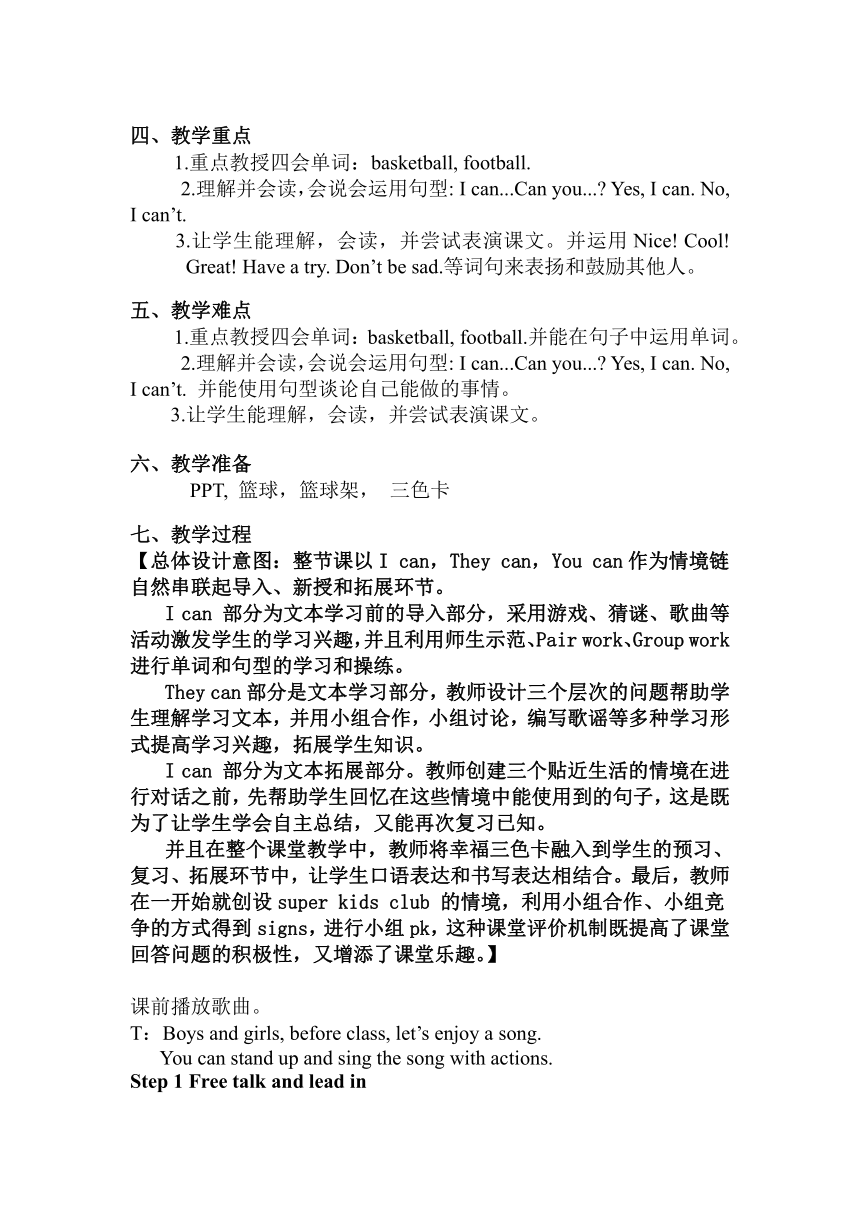
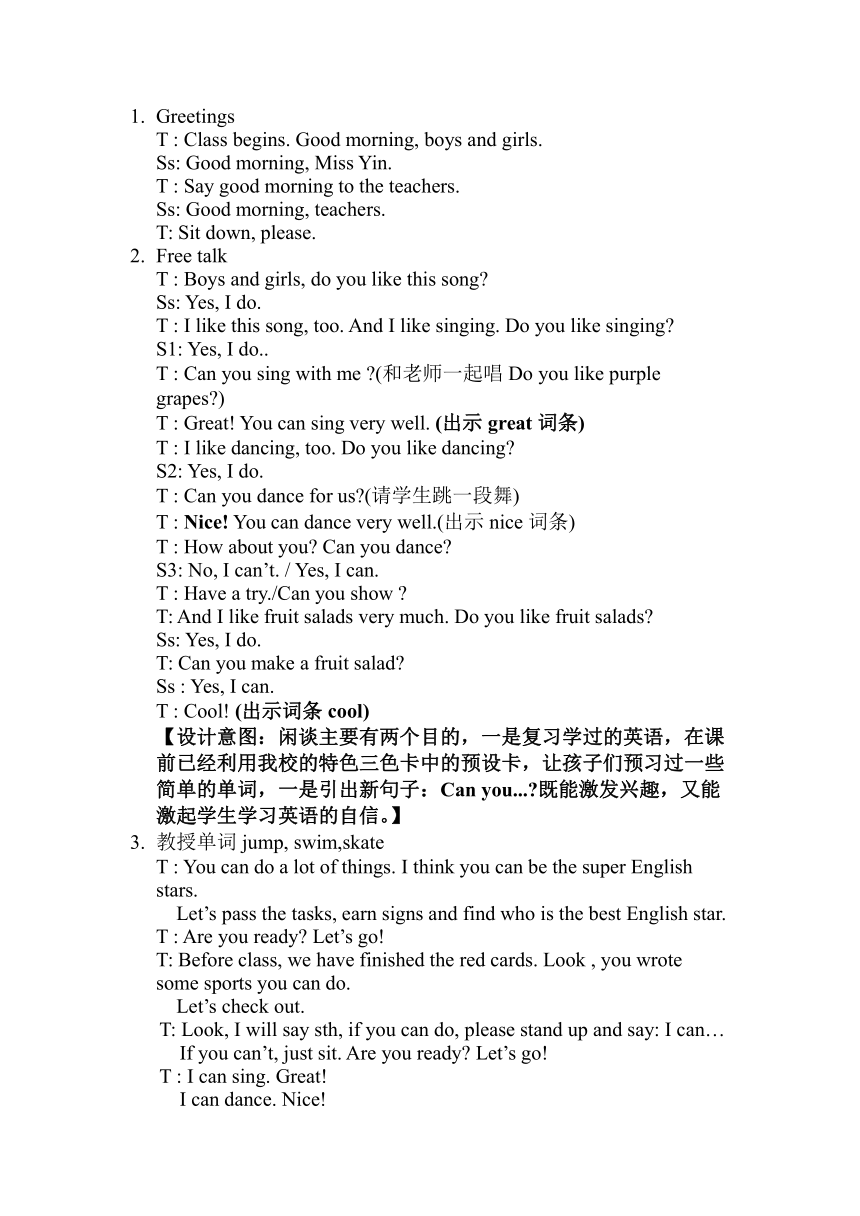
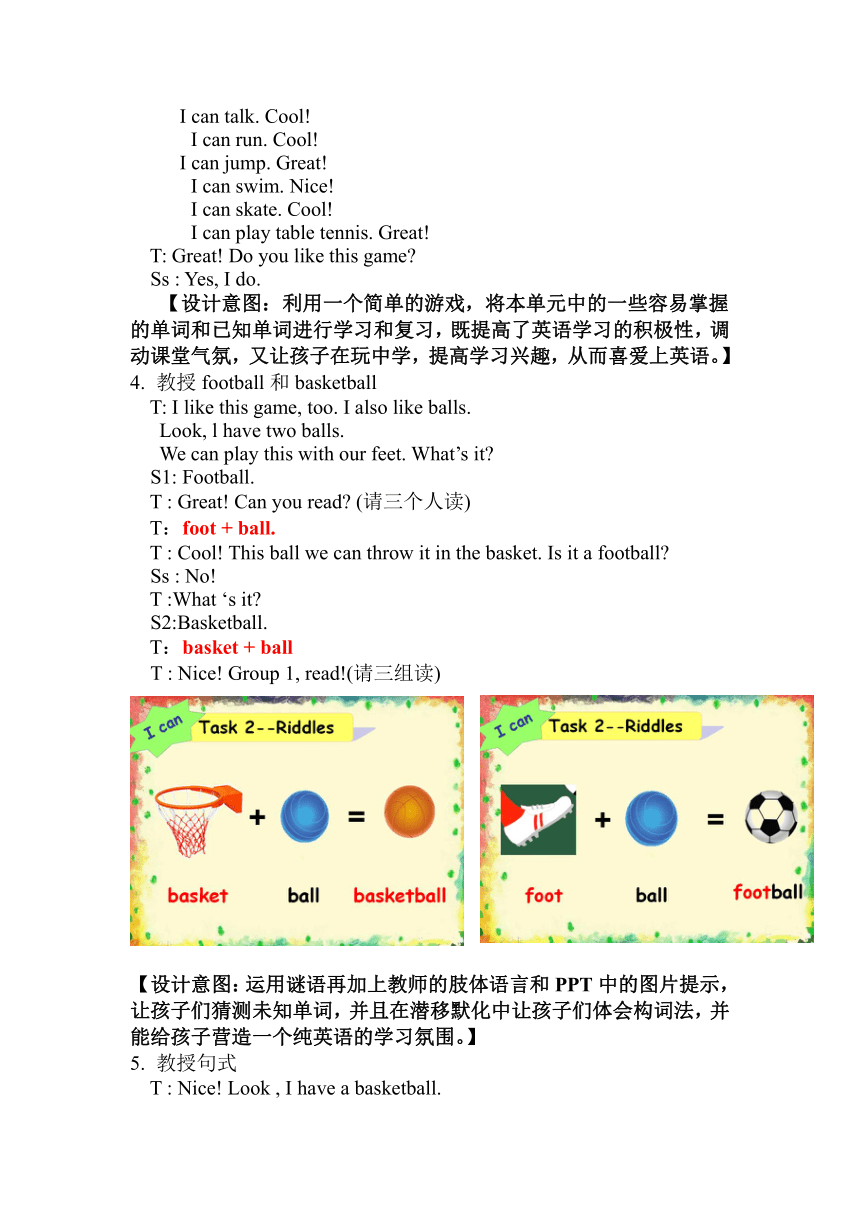
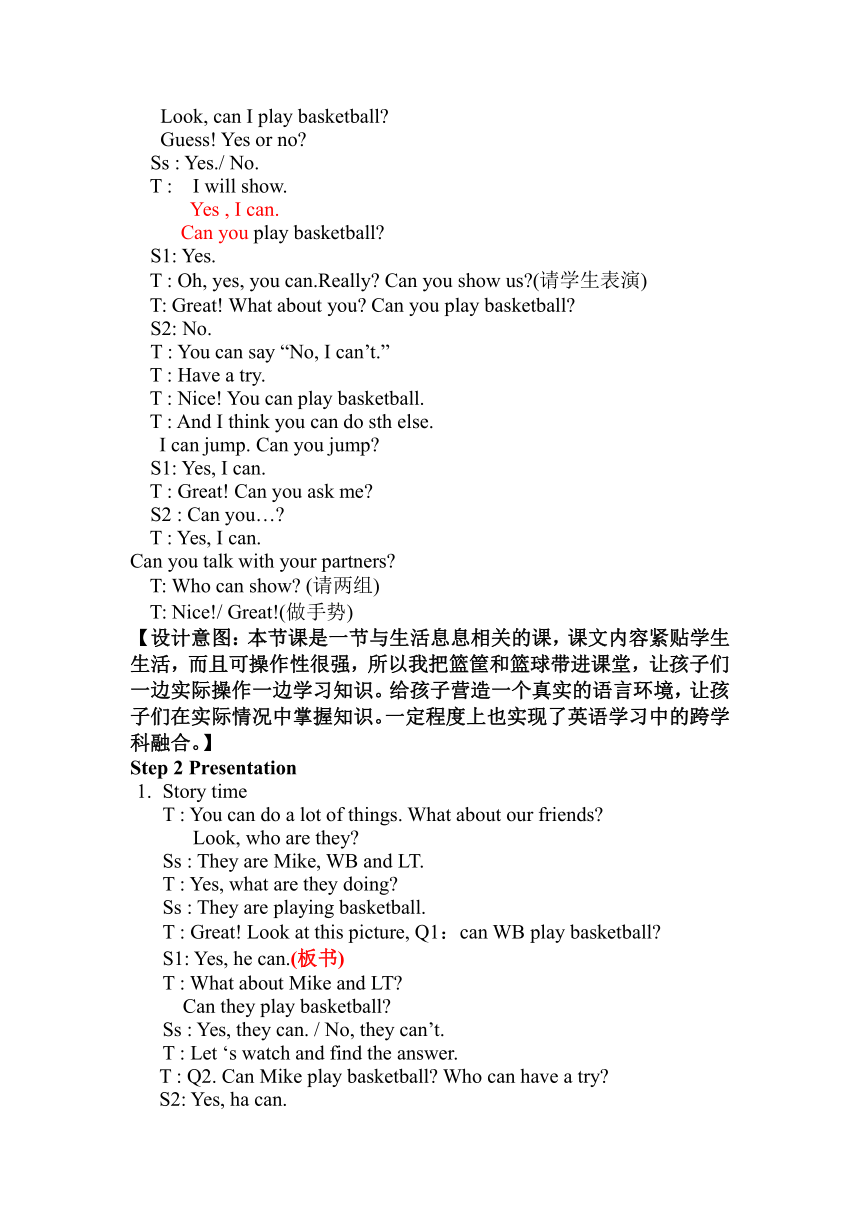
文档简介
Unit 4 I can play basketball
Story time教案设计
教材分析
本课为译林小学英语四年级上册Unit 4 《I can play basketball》。本课主要围绕着Liu Tao在Mike和Wang Bing的鼓励下学会打篮球的故事。本课的主要话题围绕运动和能力展开,让学生能够学会并运用Can you... 句型及其回答Yes, I can./No, I can’t.
学情分析
四年级学生已经有了一年多的英语基础,所以在教学上比三年级要容易些,课堂管理比较有序。大部分学生课堂表现都很活跃、很积极。课堂中会采用各种形式的游戏,及教学辅助用品一方面用来调动学生的积极性,另一方面用来帮助学生理解、记忆所学内容。
本班学生一共31人,分为三层,A层学生6人左右,学习能力较强,课内知识掌握扎实,课外知识掌握也很丰富,老师在上课时应充分调动这些学生的积极性,活跃课堂气氛,适当时候可以充当小老师的角色,以生教生。B层学生15人左右,基础扎实,单词句型学习很牢固,但一些课外的拓展部分学生接触比较少,所以在教学过程中老师需要多加引导和帮助。C层学生9人左右,这些同学基础稍弱,在课堂上教师需要多关注这些同学的掌握情况,培养他们养成良好的学习习惯。
上一单元的cartoon time 中已经接触过Can you... 句型及其回答,加之四年级学生有一定的基础,学生谈论这两点不会有太大的困难。另外,刚刚过去的国庆假期正好也是课文中谈到的,所以六年级学生谈论这个节日,有一定的环境氛围为基础,不会出现无话可说的情况。
三、教学目标
1.理解并会读,会运用会运用四会单词:basketball, football, jump, skate, swim.
2.理解并会读,会说三会单词,词组: very well , can’t, have a try.
3.理解并会读,会说会运用句型: I can...Can you... Yes, I can. No, I can’t.
Can he/she/... Yes, he/she can. No, he/she can’t.
4.能够理解并运用Nice! Cool! Great! Have a try. Don’t be sad.等词句来表扬和鼓励其他人。
四、教学重点
1.重点教授四会单词:basketball, football.
2.理解并会读,会说会运用句型: I can...Can you... Yes, I can. No, I can’t.
3.让学生能理解,会读,并尝试表演课文。并运用Nice! Cool! Great! Have a try. Don’t be sad.等词句来表扬和鼓励其他人。
五、教学难点
1.重点教授四会单词:basketball, football.并能在句子中运用单词。
2.理解并会读,会说会运用句型: I can...Can you... Yes, I can. No, I can’t. 并能使用句型谈论自己能做的事情。
3.让学生能理解,会读,并尝试表演课文。
六、教学准备
PPT, 篮球,篮球架, 三色卡
七、教学过程
【总体设计意图:整节课以I can,They can,You can作为情境链自然串联起导入、新授和拓展环节。
I can 部分为文本学习前的导入部分,采用游戏、猜谜、歌曲等活动激发学生的学习兴趣,并且利用师生示范、Pair work、Group work进行单词和句型的学习和操练。
They can部分是文本学习部分,教师设计三个层次的问题帮助学生理解学习文本,并用小组合作,小组讨论,编写歌谣等多种学习形式提高学习兴趣,拓展学生知识。
I can 部分为文本拓展部分。教师创建三个贴近生活的情境在进行对话之前,先帮助学生回忆在这些情境中能使用到的句子,这是既为了让学生学会自主总结,又能再次复习已知。
并且在整个课堂教学中,教师将幸福三色卡融入到学生的预习、复习、拓展环节中,让学生口语表达和书写表达相结合。最后,教师在一开始就创设super kids club 的情境,利用小组合作、小组竞争的方式得到signs,进行小组pk,这种课堂评价机制既提高了课堂回答问题的积极性,又增添了课堂乐趣。】
课前播放歌曲。
T:Boys and girls, before class, let’s enjoy a song.
You can stand up and sing the song with actions.
Step 1 Free talk and lead in
Greetings
T : Class begins. Good morning, boys and girls.
Ss: Good morning, Miss Yin.
T : Say good morning to the teachers.
Ss: Good morning, teachers.
T: Sit down, please.
Free talk
T : Boys and girls, do you like this song
Ss: Yes, I do.
T : I like this song, too. And I like singing. Do you like singing
S1: Yes, I do..
T : Can you sing with me (和老师一起唱Do you like purple grapes )
T : Great! You can sing very well. (出示great词条)
T : I like dancing, too. Do you like dancing
S2: Yes, I do.
T : Can you dance for us (请学生跳一段舞)
T : Nice! You can dance very well.(出示nice词条)
T : How about you Can you dance
S3: No, I can’t. / Yes, I can.
T : Have a try./Can you show
T: And I like fruit salads very much. Do you like fruit salads
Ss: Yes, I do.
T: Can you make a fruit salad
Ss : Yes, I can.
T : Cool! (出示词条cool)
【设计意图:闲谈主要有两个目的,一是复习学过的英语,在课前已经利用我校的特色三色卡中的预设卡,让孩子们预习过一些简单的单词,一是引出新句子:Can you... 既能激发兴趣,又能激起学生学习英语的自信。】
教授单词jump, swim,skate
T : You can do a lot of things. I think you can be the super English stars.
Let’s pass the tasks, earn signs and find who is the best English star.
T : Are you ready Let’s go!
T: Before class, we have finished the red cards. Look , you wrote some sports you can do.
Let’s check out.
T: Look, I will say sth, if you can do, please stand up and say: I can…
If you can’t, just sit. Are you ready Let’s go!
T : I can sing. Great!
I can dance. Nice!
I can talk. Cool!
I can run. Cool!
I can jump. Great!
I can swim. Nice!
I can skate. Cool!
I can play table tennis. Great!
T: Great! Do you like this game
Ss : Yes, I do.
【设计意图:利用一个简单的游戏,将本单元中的一些容易掌握的单词和已知单词进行学习和复习,既提高了英语学习的积极性,调动课堂气氛,又让孩子在玩中学,提高学习兴趣,从而喜爱上英语。】
教授football和basketball
T: I like this game, too. I also like balls.
Look, l have two balls.
We can play this with our feet. What’s it
S1: Football.
T : Great! Can you read (请三个人读)
T:foot + ball.
T : Cool! This ball we can throw it in the basket. Is it a football
Ss : No!
T :What ‘s it
S2:Basketball.
T:basket + ball
T : Nice! Group 1, read!(请三组读)
【设计意图:运用谜语再加上教师的肢体语言和PPT中的图片提示,让孩子们猜测未知单词,并且在潜移默化中让孩子们体会构词法,并能给孩子营造一个纯英语的学习氛围。】
教授句式
T : Nice! Look , I have a basketball.
Look, can I play basketball
Guess! Yes or no
Ss : Yes./ No.
T : I will show.
Yes , I can.
Can you play basketball
S1: Yes.
T : Oh, yes, you can.Really Can you show us (请学生表演)
T: Great! What about you Can you play basketball
S2: No.
T : You can say “No, I can’t.”
T : Have a try.
T : Nice! You can play basketball.
T : And I think you can do sth else.
I can jump. Can you jump
S1: Yes, I can.
T : Great! Can you ask me
S2 : Can you…
T : Yes, I can.
Can you talk with your partners
T: Who can show (请两组)
T: Nice!/ Great!(做手势)
【设计意图:本节课是一节与生活息息相关的课,课文内容紧贴学生生活,而且可操作性很强,所以我把篮筐和篮球带进课堂,让孩子们一边实际操作一边学习知识。给孩子营造一个真实的语言环境,让孩子们在实际情况中掌握知识。一定程度上也实现了英语学习中的跨学科融合。】
Step 2 Presentation
Story time
T : You can do a lot of things. What about our friends
Look, who are they
Ss : They are Mike, WB and LT.
T : Yes, what are they doing
Ss : They are playing basketball.
T : Great! Look at this picture, Q1:can WB play basketball
S1: Yes, he can.(板书)
T : What about Mike and LT
Can they play basketball
Ss : Yes, they can. / No, they can’t.
T : Let ‘s watch and find the answer.
T : Q2. Can Mike play basketball Who can have a try
S2: Yes, ha can.
T : How do you know Can you read
S2: He can play basketball very well.(板书)
T : Nice! Look at these words “very well”. What dose it mean
S3: 非常棒!
【设计意图:在第一遍初步接触文本的时候,先提出两个简单的概括的问题,这里教师提出了Q1:Can Mike play basketball 和Q2:Can WB play basketball 让学生大致了解课文内容,并为第二层次的问题进行铺垫。】
T : Cool! Read after me, very well, very well.
Great ! Mike can play basketball very well. What about LT Can he play basketball
S4: Yes, he can.
S5: No, he can’t.
T : We need read the story again.
I have two questions. First , can LT play at first
Second , can he play at last
Please open your books, to P 24, read and underline the answers.
T : Q1, who can answer
S1: No, he can’t.
T : How do you know Can you read (板书)
T: Cool! What about Q2
S2 : Yeah! I can play basketball.
T : Great! (板书)
【设计意图:第二遍自读课文,老师继续提出两个问题帮助孩子们阅读。Q1:Can LT play at first 和Q2:Can he play at last ,并给出阅读指导,一边阅读一边将答案勾画下来,养成良好的学习习惯。】
T:LT can play basketball at last. But how can he play at last
Who helps him
S1: Mike.
T : What does Mike say to LT
Ss : Have a try.
T : Nice! Do you know the meaning of have a try
S2: 试一试吧。
T : Cool!Can you read
S3: Have a try.
T : Teach us, please.
T : Oh, boys and girls, I can’t play football.
What can you say to me
Ss: Have a try.
T : Great! Mike says have a try to encourage LT. What else can you say to LT
Please work in groups and discuss.
T : What else can you say (请四位)
Nice! I have some sentences, too. Let’s read together.
T : Boys and girls, we can say these sentences to encourage others. OK
【设计意图:第三遍深读课文,教师提出一个问题Who helps him 了解了是王兵和麦克的鼓励让刘涛重拾信心再试一次。这个时候,让孩子们小组合作讨论还知道那些鼓励别人的话语,然后进行交流。这样的设计,既培养了学生协作合作的能力,有将课内的知识拓展到了课外,丰富大家的知识。】
Reading time
listen and repeat
T: You can answer questions very well. Can you read well, too
Let’ s listen and repeat.
read with actions
T: Great! The task will be harder. Please read after me with actions.
(纠正读音,并指导动作)
happy show
T: After reading, there is a happy show.
You can choose read in groups, read in roles or act in roles.
If you can use your own words, i will give you more signs.
Work in 3, please act.
(请两组表演)
T : (使用手势语提醒孩子表扬) How many signs
Summary
T: Wow, what a wonderful show!
You must know this story very well. Let’s review.
Take out your yellow cards.
T: Please fill in the blanks with your partners.
T : Who can answer You two please.(两人一组回答)
T : Great!Now, let’s read it together.
T : I will change another way. Can you sing it
Let’ s sing together.
【设计意图:在课文学习的最后,教师将课文内容设计成一段韵律诗,让学生两两合作完成填空,然后在节奏中核对答案。这种新奇的教学设计,既帮助学生复习本节课所学的课文内容,又增加了学习的趣味性,真正做到让儿童爱上学习,乐于学习。并且将三色卡中的分享卡运用进来,前后呼应,又锻炼了学生的笔试能力。】
Step 3 Consolidations
T : Great! You are the real super students. I think you can do many thing else.
Look, I have three situations.
How do you talk about them
What sentences can you use Please talk in 2 and discuss.(给一些提示)
T : What sentences can you use
I can… can you…
Yes, I can. No, I can’t.
T : Who can have a try
(请一个人示范)
T : Cool! Please take out your blue cards, work in 2, choose one and make a new dialogue.
Don’t forget use these sentences.
(请两组)
T : Great! Boys and girls, you earned many signs.
Let’s check. Group 1, how many signs did you earn
…
So group 3 is the super group.
Congratulations!(用动作提示学生夸奖最佳小组)
T : Other groups, don’t be sad. You can do your best and try again next time.
That’ s all for today’s class.
Class is over.
Goodbye, my super students.
Say goodbye to the teachers.
【设计意图: 在整节课的最后,教师给学生创造了三个贴近现实的情境,在进行对话之前,先帮助学生回忆在这些情境中能使用到的句子,这是既为了让学生学会自主总结,又能再次复习已知。并且,将这个部分融入到三色卡的拓展卡中,将整节课串联起来,一步一步的达到教学目标,在课文内容的基础上让学生真正的学会运用。】
八、板书设计
九、学生学习评价
教师在一开始就创设super kids club 的情境,利用小组合作、小组竞争的方式得到signs,进行小组pk,这种课堂评价机制既提高了课堂回答问题的积极性,又增添了课堂乐趣。
在最后,教师设计的拓展卡,将本节课的只是进行整合,让学生填写后,收好批改进行学习反馈,并及时进行评价。
十、课后自我反思
1.巧用多样化手段,激趣增效课堂口语交际
哈佛大学认知心理学家加德纳提出了多元智能理论。他认为我们每个人都拥有八种主要智能:语言智能、逻辑——数理智能、空间智能、运动智能、音乐智能、人际交往智能、内省智能、自然观察智能。所以孩子们都有自己的智力特点学习类型和发展方向,作为老师,不应当仅仅关注自己所教学科的知识,更应该关注孩子的多元智能的发展。作为老师,不应当仅仅关注自己所教学科的知识,更应该关注孩子的多元智能的发展。本课中教师在一开始就创设super kids club 的情境,利用小组合作、小组竞争的方式得到signs,进行小组pk,这种课堂评价机制既提高了课堂回答问题的积极性,又增添了课堂乐趣。并且,在课堂活动中充分利用了面具、手偶等可爱课堂工具,还采用游戏、猜谜、歌曲等活动激发学生的学习兴趣,并且利用师生示范、Pair work、Group work进行单词和句型的学习和操练。
2.搭建渐进性支架,创设情境促进知识生成
在维果茨基的认知发展理论中,最受重视的是他倡议的可能发展区(或叫最近发展区)的理念。最近发展区理论认为:儿童的学习状态可以分为两种水平:一种是目前已经达到的发展水平,表现为学生能够独立解决问题的智力水平;一种是潜在的可能达到的水平,这两种水平之间的距离就是最近发展区。学生都有潜在发展水平。它表现为儿童还不能独立地完成任务,但在成人的帮助下,在集体活动中,通过模仿,从而能够完成这些任务。例如本课中教师设计深入浅出的渐进性问题,引导学生深入学习文本;还有教师实用的幸福三色卡,有预设,分享、拓展三个方面帮助孩子学习,教师设计的各种活动情境趣化了教师教学的“导学”、学生“会学”过程,让孩子们感受到学习英语的乐趣。
3.注重情智化引导,师生合力实现自主乐学
当下的教育主张情智教育。情智教育就是指教育者动用积极的情感和灵动的智慧作用与受教育者,让受教育者的情感和智慧和谐共生。现在的小学英语教学,经常是灌输式的,表面上看似“学会”了,但是实际上却本末倒置。英语教师在日常课堂教学中,更应该用智慧搭建“脚手架”。[5]《义务教育英语课程标准2011版》主张学生在语境中接触,体验和理解真实语言,并在此基础上学习和运用语言。在教学中,一味地只是老师在传授,而忽略了学生的主体地位,很多孩子看似学会,却无法举一反三。而要培养具有终身“学习力”的人,教师的关注点应该要放在终身“会学”上。情智化教学过程,营造生动活泼的课堂氛围,另一方面有利于师生思维的交流碰撞,促进学生自主学习和团队合作意识的形成,培养乐学好思的优良品质,形成以学生为主体的课堂环境。
Story time教案设计
教材分析
本课为译林小学英语四年级上册Unit 4 《I can play basketball》。本课主要围绕着Liu Tao在Mike和Wang Bing的鼓励下学会打篮球的故事。本课的主要话题围绕运动和能力展开,让学生能够学会并运用Can you... 句型及其回答Yes, I can./No, I can’t.
学情分析
四年级学生已经有了一年多的英语基础,所以在教学上比三年级要容易些,课堂管理比较有序。大部分学生课堂表现都很活跃、很积极。课堂中会采用各种形式的游戏,及教学辅助用品一方面用来调动学生的积极性,另一方面用来帮助学生理解、记忆所学内容。
本班学生一共31人,分为三层,A层学生6人左右,学习能力较强,课内知识掌握扎实,课外知识掌握也很丰富,老师在上课时应充分调动这些学生的积极性,活跃课堂气氛,适当时候可以充当小老师的角色,以生教生。B层学生15人左右,基础扎实,单词句型学习很牢固,但一些课外的拓展部分学生接触比较少,所以在教学过程中老师需要多加引导和帮助。C层学生9人左右,这些同学基础稍弱,在课堂上教师需要多关注这些同学的掌握情况,培养他们养成良好的学习习惯。
上一单元的cartoon time 中已经接触过Can you... 句型及其回答,加之四年级学生有一定的基础,学生谈论这两点不会有太大的困难。另外,刚刚过去的国庆假期正好也是课文中谈到的,所以六年级学生谈论这个节日,有一定的环境氛围为基础,不会出现无话可说的情况。
三、教学目标
1.理解并会读,会运用会运用四会单词:basketball, football, jump, skate, swim.
2.理解并会读,会说三会单词,词组: very well , can’t, have a try.
3.理解并会读,会说会运用句型: I can...Can you... Yes, I can. No, I can’t.
Can he/she/... Yes, he/she can. No, he/she can’t.
4.能够理解并运用Nice! Cool! Great! Have a try. Don’t be sad.等词句来表扬和鼓励其他人。
四、教学重点
1.重点教授四会单词:basketball, football.
2.理解并会读,会说会运用句型: I can...Can you... Yes, I can. No, I can’t.
3.让学生能理解,会读,并尝试表演课文。并运用Nice! Cool! Great! Have a try. Don’t be sad.等词句来表扬和鼓励其他人。
五、教学难点
1.重点教授四会单词:basketball, football.并能在句子中运用单词。
2.理解并会读,会说会运用句型: I can...Can you... Yes, I can. No, I can’t. 并能使用句型谈论自己能做的事情。
3.让学生能理解,会读,并尝试表演课文。
六、教学准备
PPT, 篮球,篮球架, 三色卡
七、教学过程
【总体设计意图:整节课以I can,They can,You can作为情境链自然串联起导入、新授和拓展环节。
I can 部分为文本学习前的导入部分,采用游戏、猜谜、歌曲等活动激发学生的学习兴趣,并且利用师生示范、Pair work、Group work进行单词和句型的学习和操练。
They can部分是文本学习部分,教师设计三个层次的问题帮助学生理解学习文本,并用小组合作,小组讨论,编写歌谣等多种学习形式提高学习兴趣,拓展学生知识。
I can 部分为文本拓展部分。教师创建三个贴近生活的情境在进行对话之前,先帮助学生回忆在这些情境中能使用到的句子,这是既为了让学生学会自主总结,又能再次复习已知。
并且在整个课堂教学中,教师将幸福三色卡融入到学生的预习、复习、拓展环节中,让学生口语表达和书写表达相结合。最后,教师在一开始就创设super kids club 的情境,利用小组合作、小组竞争的方式得到signs,进行小组pk,这种课堂评价机制既提高了课堂回答问题的积极性,又增添了课堂乐趣。】
课前播放歌曲。
T:Boys and girls, before class, let’s enjoy a song.
You can stand up and sing the song with actions.
Step 1 Free talk and lead in
Greetings
T : Class begins. Good morning, boys and girls.
Ss: Good morning, Miss Yin.
T : Say good morning to the teachers.
Ss: Good morning, teachers.
T: Sit down, please.
Free talk
T : Boys and girls, do you like this song
Ss: Yes, I do.
T : I like this song, too. And I like singing. Do you like singing
S1: Yes, I do..
T : Can you sing with me (和老师一起唱Do you like purple grapes )
T : Great! You can sing very well. (出示great词条)
T : I like dancing, too. Do you like dancing
S2: Yes, I do.
T : Can you dance for us (请学生跳一段舞)
T : Nice! You can dance very well.(出示nice词条)
T : How about you Can you dance
S3: No, I can’t. / Yes, I can.
T : Have a try./Can you show
T: And I like fruit salads very much. Do you like fruit salads
Ss: Yes, I do.
T: Can you make a fruit salad
Ss : Yes, I can.
T : Cool! (出示词条cool)
【设计意图:闲谈主要有两个目的,一是复习学过的英语,在课前已经利用我校的特色三色卡中的预设卡,让孩子们预习过一些简单的单词,一是引出新句子:Can you... 既能激发兴趣,又能激起学生学习英语的自信。】
教授单词jump, swim,skate
T : You can do a lot of things. I think you can be the super English stars.
Let’s pass the tasks, earn signs and find who is the best English star.
T : Are you ready Let’s go!
T: Before class, we have finished the red cards. Look , you wrote some sports you can do.
Let’s check out.
T: Look, I will say sth, if you can do, please stand up and say: I can…
If you can’t, just sit. Are you ready Let’s go!
T : I can sing. Great!
I can dance. Nice!
I can talk. Cool!
I can run. Cool!
I can jump. Great!
I can swim. Nice!
I can skate. Cool!
I can play table tennis. Great!
T: Great! Do you like this game
Ss : Yes, I do.
【设计意图:利用一个简单的游戏,将本单元中的一些容易掌握的单词和已知单词进行学习和复习,既提高了英语学习的积极性,调动课堂气氛,又让孩子在玩中学,提高学习兴趣,从而喜爱上英语。】
教授football和basketball
T: I like this game, too. I also like balls.
Look, l have two balls.
We can play this with our feet. What’s it
S1: Football.
T : Great! Can you read (请三个人读)
T:foot + ball.
T : Cool! This ball we can throw it in the basket. Is it a football
Ss : No!
T :What ‘s it
S2:Basketball.
T:basket + ball
T : Nice! Group 1, read!(请三组读)
【设计意图:运用谜语再加上教师的肢体语言和PPT中的图片提示,让孩子们猜测未知单词,并且在潜移默化中让孩子们体会构词法,并能给孩子营造一个纯英语的学习氛围。】
教授句式
T : Nice! Look , I have a basketball.
Look, can I play basketball
Guess! Yes or no
Ss : Yes./ No.
T : I will show.
Yes , I can.
Can you play basketball
S1: Yes.
T : Oh, yes, you can.Really Can you show us (请学生表演)
T: Great! What about you Can you play basketball
S2: No.
T : You can say “No, I can’t.”
T : Have a try.
T : Nice! You can play basketball.
T : And I think you can do sth else.
I can jump. Can you jump
S1: Yes, I can.
T : Great! Can you ask me
S2 : Can you…
T : Yes, I can.
Can you talk with your partners
T: Who can show (请两组)
T: Nice!/ Great!(做手势)
【设计意图:本节课是一节与生活息息相关的课,课文内容紧贴学生生活,而且可操作性很强,所以我把篮筐和篮球带进课堂,让孩子们一边实际操作一边学习知识。给孩子营造一个真实的语言环境,让孩子们在实际情况中掌握知识。一定程度上也实现了英语学习中的跨学科融合。】
Step 2 Presentation
Story time
T : You can do a lot of things. What about our friends
Look, who are they
Ss : They are Mike, WB and LT.
T : Yes, what are they doing
Ss : They are playing basketball.
T : Great! Look at this picture, Q1:can WB play basketball
S1: Yes, he can.(板书)
T : What about Mike and LT
Can they play basketball
Ss : Yes, they can. / No, they can’t.
T : Let ‘s watch and find the answer.
T : Q2. Can Mike play basketball Who can have a try
S2: Yes, ha can.
T : How do you know Can you read
S2: He can play basketball very well.(板书)
T : Nice! Look at these words “very well”. What dose it mean
S3: 非常棒!
【设计意图:在第一遍初步接触文本的时候,先提出两个简单的概括的问题,这里教师提出了Q1:Can Mike play basketball 和Q2:Can WB play basketball 让学生大致了解课文内容,并为第二层次的问题进行铺垫。】
T : Cool! Read after me, very well, very well.
Great ! Mike can play basketball very well. What about LT Can he play basketball
S4: Yes, he can.
S5: No, he can’t.
T : We need read the story again.
I have two questions. First , can LT play at first
Second , can he play at last
Please open your books, to P 24, read and underline the answers.
T : Q1, who can answer
S1: No, he can’t.
T : How do you know Can you read (板书)
T: Cool! What about Q2
S2 : Yeah! I can play basketball.
T : Great! (板书)
【设计意图:第二遍自读课文,老师继续提出两个问题帮助孩子们阅读。Q1:Can LT play at first 和Q2:Can he play at last ,并给出阅读指导,一边阅读一边将答案勾画下来,养成良好的学习习惯。】
T:LT can play basketball at last. But how can he play at last
Who helps him
S1: Mike.
T : What does Mike say to LT
Ss : Have a try.
T : Nice! Do you know the meaning of have a try
S2: 试一试吧。
T : Cool!Can you read
S3: Have a try.
T : Teach us, please.
T : Oh, boys and girls, I can’t play football.
What can you say to me
Ss: Have a try.
T : Great! Mike says have a try to encourage LT. What else can you say to LT
Please work in groups and discuss.
T : What else can you say (请四位)
Nice! I have some sentences, too. Let’s read together.
T : Boys and girls, we can say these sentences to encourage others. OK
【设计意图:第三遍深读课文,教师提出一个问题Who helps him 了解了是王兵和麦克的鼓励让刘涛重拾信心再试一次。这个时候,让孩子们小组合作讨论还知道那些鼓励别人的话语,然后进行交流。这样的设计,既培养了学生协作合作的能力,有将课内的知识拓展到了课外,丰富大家的知识。】
Reading time
listen and repeat
T: You can answer questions very well. Can you read well, too
Let’ s listen and repeat.
read with actions
T: Great! The task will be harder. Please read after me with actions.
(纠正读音,并指导动作)
happy show
T: After reading, there is a happy show.
You can choose read in groups, read in roles or act in roles.
If you can use your own words, i will give you more signs.
Work in 3, please act.
(请两组表演)
T : (使用手势语提醒孩子表扬) How many signs
Summary
T: Wow, what a wonderful show!
You must know this story very well. Let’s review.
Take out your yellow cards.
T: Please fill in the blanks with your partners.
T : Who can answer You two please.(两人一组回答)
T : Great!Now, let’s read it together.
T : I will change another way. Can you sing it
Let’ s sing together.
【设计意图:在课文学习的最后,教师将课文内容设计成一段韵律诗,让学生两两合作完成填空,然后在节奏中核对答案。这种新奇的教学设计,既帮助学生复习本节课所学的课文内容,又增加了学习的趣味性,真正做到让儿童爱上学习,乐于学习。并且将三色卡中的分享卡运用进来,前后呼应,又锻炼了学生的笔试能力。】
Step 3 Consolidations
T : Great! You are the real super students. I think you can do many thing else.
Look, I have three situations.
How do you talk about them
What sentences can you use Please talk in 2 and discuss.(给一些提示)
T : What sentences can you use
I can… can you…
Yes, I can. No, I can’t.
T : Who can have a try
(请一个人示范)
T : Cool! Please take out your blue cards, work in 2, choose one and make a new dialogue.
Don’t forget use these sentences.
(请两组)
T : Great! Boys and girls, you earned many signs.
Let’s check. Group 1, how many signs did you earn
…
So group 3 is the super group.
Congratulations!(用动作提示学生夸奖最佳小组)
T : Other groups, don’t be sad. You can do your best and try again next time.
That’ s all for today’s class.
Class is over.
Goodbye, my super students.
Say goodbye to the teachers.
【设计意图: 在整节课的最后,教师给学生创造了三个贴近现实的情境,在进行对话之前,先帮助学生回忆在这些情境中能使用到的句子,这是既为了让学生学会自主总结,又能再次复习已知。并且,将这个部分融入到三色卡的拓展卡中,将整节课串联起来,一步一步的达到教学目标,在课文内容的基础上让学生真正的学会运用。】
八、板书设计
九、学生学习评价
教师在一开始就创设super kids club 的情境,利用小组合作、小组竞争的方式得到signs,进行小组pk,这种课堂评价机制既提高了课堂回答问题的积极性,又增添了课堂乐趣。
在最后,教师设计的拓展卡,将本节课的只是进行整合,让学生填写后,收好批改进行学习反馈,并及时进行评价。
十、课后自我反思
1.巧用多样化手段,激趣增效课堂口语交际
哈佛大学认知心理学家加德纳提出了多元智能理论。他认为我们每个人都拥有八种主要智能:语言智能、逻辑——数理智能、空间智能、运动智能、音乐智能、人际交往智能、内省智能、自然观察智能。所以孩子们都有自己的智力特点学习类型和发展方向,作为老师,不应当仅仅关注自己所教学科的知识,更应该关注孩子的多元智能的发展。作为老师,不应当仅仅关注自己所教学科的知识,更应该关注孩子的多元智能的发展。本课中教师在一开始就创设super kids club 的情境,利用小组合作、小组竞争的方式得到signs,进行小组pk,这种课堂评价机制既提高了课堂回答问题的积极性,又增添了课堂乐趣。并且,在课堂活动中充分利用了面具、手偶等可爱课堂工具,还采用游戏、猜谜、歌曲等活动激发学生的学习兴趣,并且利用师生示范、Pair work、Group work进行单词和句型的学习和操练。
2.搭建渐进性支架,创设情境促进知识生成
在维果茨基的认知发展理论中,最受重视的是他倡议的可能发展区(或叫最近发展区)的理念。最近发展区理论认为:儿童的学习状态可以分为两种水平:一种是目前已经达到的发展水平,表现为学生能够独立解决问题的智力水平;一种是潜在的可能达到的水平,这两种水平之间的距离就是最近发展区。学生都有潜在发展水平。它表现为儿童还不能独立地完成任务,但在成人的帮助下,在集体活动中,通过模仿,从而能够完成这些任务。例如本课中教师设计深入浅出的渐进性问题,引导学生深入学习文本;还有教师实用的幸福三色卡,有预设,分享、拓展三个方面帮助孩子学习,教师设计的各种活动情境趣化了教师教学的“导学”、学生“会学”过程,让孩子们感受到学习英语的乐趣。
3.注重情智化引导,师生合力实现自主乐学
当下的教育主张情智教育。情智教育就是指教育者动用积极的情感和灵动的智慧作用与受教育者,让受教育者的情感和智慧和谐共生。现在的小学英语教学,经常是灌输式的,表面上看似“学会”了,但是实际上却本末倒置。英语教师在日常课堂教学中,更应该用智慧搭建“脚手架”。[5]《义务教育英语课程标准2011版》主张学生在语境中接触,体验和理解真实语言,并在此基础上学习和运用语言。在教学中,一味地只是老师在传授,而忽略了学生的主体地位,很多孩子看似学会,却无法举一反三。而要培养具有终身“学习力”的人,教师的关注点应该要放在终身“会学”上。情智化教学过程,营造生动活泼的课堂氛围,另一方面有利于师生思维的交流碰撞,促进学生自主学习和团队合作意识的形成,培养乐学好思的优良品质,形成以学生为主体的课堂环境。
